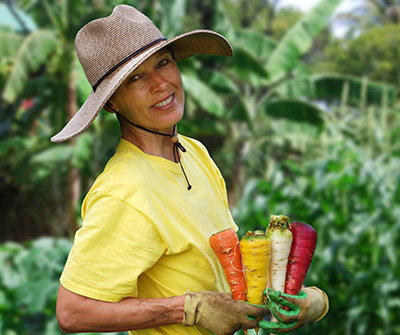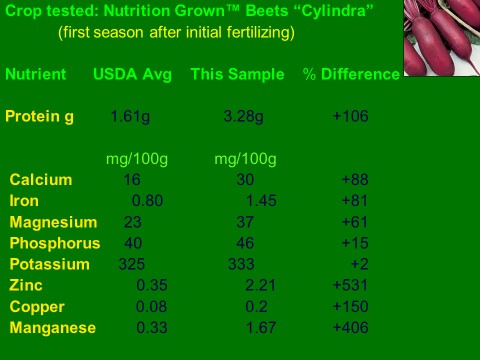TGN Interviews Soil Scientist Jana Bogs, PhD, on the Beyond Organic Method, Today’s Nutrient-Deficient Organic Crops, and How to Optimize Soil Health
Nominee: Jana Bogs, PhD
Home Digs: Big Island of Hawaii
Organization: Beyond Organic Consulting, Inc.
Follow At: Beyond Organic Research (Website); Beyond Organic Research and Consulting (Facebook); @DrBogs Blog (Twitter)
Fast Facts: Human health starts in the soil. It’s a bold statement, but one Jana Bogs, PhD, stands by. The nutritionist turned horticulturist turned research scientist is on a mission to set a new standard in agriculture by promoting Nutrition Grown™ food practices. Fortunately for Dr. Bogs, her research “lab” is lush acreage on the Big Island of Hawaii, “where we have 11 of the 13 climates in the world!” Working with growers across the United States and Canada, she advocates for optimal growing that nurtures the largest variety of healthful plant compounds—interweaving the soil science, horticulture, and food familiarity that heighten plant, human, and animal nutrition. It’s all in her free new video mini-course “Creating Health From the Soil Up!” at BeyondOrganicResearch.com. To that, we say, mahalo!
___________________________________________
You point out that commercially farmed crops have lost up to 70 percent of some nutrients compared to 70 years ago. How do these statistics compare with organically grown crops, and why should we be concerned?
There have been hundreds of scientific studies comparing the nutrient content of organically grown foods with that of conventionally grown foods. The overall results show little difference. The nutrient content of the food really depends on the quality of the soil. Some organic foods aren’t even grown in soil anymore. According to holistic doctors who test patients for nutrient deficiencies, the vast majority of those tested do show deficiencies. The good news is that we can turn this around by optimizing our soil, which in turn optimizes our food.
Your research shows that optimal growing practices result in a “fuller genetic expression” of essential plant tissue compounds. Can you offer some specific examples of these phytonutrients so beneficial to human health?
There are actually thousands of these plant compounds known as phytonutrients. “Phyto” means plant. Many of these are polyphenols, which act as antioxidants in our bodies. Some examples you may have heard of include resveratrol, which occurs in grapes, rutin in buckwheat, and curcumin in turmeric. Another class of phytonutrients is thiols, which occur in sulfur-bearing cruciferous vegetables. These are detoxification compounds. Examples are allicin in garlic and sulforaphane in cabbage. Another class of phytonutrients is terpenes. This group includes carotenes and xanthophylls, such as lutein and zeaxanthin, which are important for eye health.
Say we want to grow the most nutrient-dense fruits and veggies possible this year. Walk us through the first steps of optimizing our garden soil through nutrient analysis sampling.
The first thing to do is to make sure you have a sunny location for your garden. Clear off grass and weeds. Getting a high-quality, comprehensive soil analysis—which is interpreted for increasing the nutrient content of your food—is of the upmost importance. This analysis should include 18+ minerals, pH, total cation exchange capacity (TCEC), electrical conductivity (EC), and organic matter percentage. Obtain a soil sample by taking multiple core samples across the garden, each 6 inches deep. Mix those together in a clean bucket to achieve a representative sample. Put about 2 cups of soil in a plastic zipper-lock bag and package carefully for mailing. I include step-by-step instructions on my website about how to do this.
Should we also test our soil for crucial microbes? Please describe the science behind microbial analysis and your go-to steps and products.
Taking care of the soil microbes will pay big dividends, as these microbes will make nutrients available to your plants. It’s great if you can get your soil tested for types and amounts of microbes. What I usually see with microbial analysis is a predominance of bacteria and not enough beneficial fungi. This imbalance encourages weeds. It is very important to balance your soil with the minerals and organic matter it needs to support a good diversity and number of beneficial microbes. For example, getting the right amount of calcium into the soil will help it become fluffier, with more air for the microbes. Cobalt is a mineral that is essential for microbes to make vitamin B-12, which they must have to live. Phosphorus, such as from soft rock phosphate, is very important for encouraging beneficial fungi. Using microbial inoculants, especially those with mycorrhizal fungi, can be helpful to add beneficial microbial strains to your soil. Just remember, though, that you can put microbes out, but they won’t survive for long without the right balance of nutrients in the soil.
Once we’ve analyzed our soil, what are your top 5 practical tips for applying soil amendments?
A good soil analysis will test for about 18 different minerals and come with specific recommendations for exact types and amounts of various minerals and other items to apply to your garden.
- You will want to buy organically approved items to add to your soil to help avoid heavy metal contamination. You can look for the Organic Materials Review Institute (OMRI) label on products. Not every product has to have that label, but it is good to research the quality of items you put on your garden. Be careful to buy exactly what is recommended. For example, there are several forms of calcium, such as limestone, gypsum, dolomite, and calcium silicate. Each has specific uses—they are not interchangeable.
- Calculate the amounts of each item needed to be applied based on the square footage of your garden. Weigh each item carefully. For items needed in small amounts, mix these together well. Be sure to break up any lumps in the materials.
- A drop spreader is a helpful tool for spreading amendments evenly.
- Always wear a mask over your nose and mouth as well as non-permeable gloves when handling fertilizers and amendments. Apply when it is not windy.
- Blend amendments into soil 6 inches deep, if possible, to get nutrients down into the root zone. This is especially important when applying phosphorus. For no-till situations, cut down on the volume of amendments applied.
Optimizing soil takes time. Plan on getting your soil retested at least every year or, even better, every 6 months, especially at first.
Is plant tissue analysis a necessary step in producing “nutrition grown” food as well? How do foliar sprays play into the equation?
Plant tissue analysis can be used to determine custom foliar spray applications of specific nutrients, which are great to boost the health and nutrient content of your plants quickly. Plant tissue analysis is also used to determine the actual nutrient content of what you have grown compared to typical values. Custom foliar sprays are especially important for established crops, such as fruit trees, where soil amendments cannot be tilled into the ground.
We really don’t want to hear that tomatoes (an annual garden favorite) contain harmful lectins. How do these proteins react in the body, and how can we reduce their effect in the foods we consume?
Lectins are naturally occurring plant compounds that are meant to protect the plants from attack by insects and diseases. In certain foods, however, these lectins are specific proteins that cause red blood cells to clump up. They are further considered an anti-nutrient because they also bind to certain carbohydrates and inhibit nutrient uptake. Some people are more sensitive to lectins than others, but health issues include arthritis-type symptoms, autoimmune conditions, weight gain, brain fog, and allergies. To decrease the lectin content, peel and remove the seeds from tomatoes, cucumbers, squash, peppers, etc. (typically New World foods). Lectins occur in beans, peas, and grains, too. Cooking, especially pressure cooking, helps break down the lectins. Dr. Steven Gundry’s book, The Plant Paradox, goes into details.
Any last tidbit of gardening, eating, or healthy living advice that would be of interest to our Grow Network community?
I love Marjory’s [founder of The Grow Network] message to “Grow Your Own Groceries.” Eating a large portion of your foods absolutely fresh and raw from your garden will supply you with lots of biophoton life energy. This is the life-animating energy which helps your own cells to function optimally. Also, choose types and cultivars of plants that are naturally more nutritious, such as dark leafy greens over iceberg lettuce. Usually, the deeper the color, the more phytonutrients will be present. Finally, seeds produced from plants grown in optimized soil will produce better-quality plants—so plan on saving seeds from your best plants to continually improve your harvest quality and quantity.
Let’s be sure that we’re growing in an optimized, Beyond Organic way to maximize the nutritional and biophoton content of our foods, so we can optimize our health. You can learn much more with my new video mini-course, “Creating Health From the Soil Up!”
_________________
The Grow Network is a participant in the Amazon Services LLC Associates Program, an affiliate program designed to provide a means for our team to earn fees for recommending our favorite products! We may earn a small commission, at no additional cost to you, should you purchase an item after clicking one of our links. Thanks for supporting TGN!

The Grow Network is a global network of people who produce their own food and medicine. We’re the coolest bunch of backyard researchers on Earth! We’re constantly sharing, discovering, and working together to test new paths for sustainable living—while reconnecting with the “old ways” that are slipping away in our modern world. We value soil, water, sunlight, simplicity, sustainability, usefulness, and freedom. We strive to produce, prepare, and preserve our own food and medicine, and we hope you do, too!









